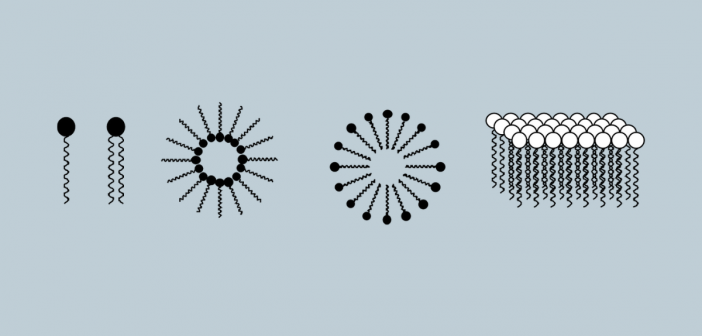Dr. Ashish Verma, biochemical engineering consultant on Kolabtree, writes about the production and applications of biosurfactants.
The term surfactant is a blend of surface active agent. Surfactants are usually organic compounds that are amphiphilic, meaning they contain both hydrophobic groups (their “tails”) and hydrophilic groups (their “heads”). Therefore, they are soluble in both organic solvents and water. The term surfactant was coined by Antara products in 1950.
Surfactants reduce the surface tension of water by adsorbing at the liquid-gas interface. They also reduce the interfacial tension between oil and water by adsorbing at the liquid-liquid interface. Many surfactants can also assemble in the bulk solution into aggregates. Examples of such aggregates are vesicles and micelles. The concentration at which surfactants begin to form micelles is known as the critical micelle concentration or CMC. When micelles form in water, their tails form a core that can encapsulate an oil droplet, and their (ionic/polar) heads form an outer shell that maintains favorable contact with water.
Global surfactant demand increases day by day due to its large application in various sectors such as enhanced oil recovery, soil and aquifer remediation, foods, pharmaceuticals, cosmetics, herbicides, pesticides, leather industries, house hold, paint industries etc. Global surfactants market demand was 15.93 million tons in 2014 and is expected to reach 24.19 million tons by 2022, growing at a CAGR of 5.4% from 2015 to 2022.
Production of biosurfactants
Almost all synthetic surfactants currently in use are chemically derived from petroleum. These compounds are usually toxic to environment, and they can release toxic chemicals when they decompose, they are toxic to human skin and also there by-products can be environmental hazardous, due to its persistent (non-biodegradable) nature they can negatively affect the soil fertility and also contaminate the water bodies. In spite of these disadvantages their use increases day by day globally in both industries and households.
That’s where biosurfactants come in. Biosurfactants are surface-active compounds produced by living cells. Their nature and surface tension-reducing abilities depend on the type and strain microorganism (bacteria, yeast, fungi) used and the available nutrient substrate for cell growth.
Microbial surfactants/Biosurfactants are surface-active metabolites produced by microorganisms when grown on water miscible or oily substrates: they either remain adherent to Microbial cell surfaces or are secreted in the culture broth.
Microbial surfactants constitute a diverse group of surface-active molecules and are known to occur in a variety of chemical structures, such as glycolipids, lipopeptides and lipoproteins, fatty acids, neutral lipids, phospholipids, and polymeric and particulate structures. The features that make them commercially promising alternatives to chemically synthesized surfactants are their lower toxicity, higher biodegradability and, hence, greater environmental compatibility, better foaming properties (useful in mineral processing), and stable activity at extremes of pH, salinity and temperature.
Biosurfactant activities can be determined by measuring the changes in surface and interfacial tensions, stabilization or destabilization of emulsions, and hydrophilic-lipophilic balance (HLB). Surface tension at the air/water and oil/water interfaces can easily be measured with a tensiometer. Biosurfactants have unique properties that chemical synthesized surfactants do not have, such as high surface activity, environmental friendliness, lower toxicity, biodegradability, ecological acceptability, good anti-microbial activity and do not lose physico-chemical properties at different temperatures, pH and salinity levels. They are widely used in microbial-enhanced oil recovery (MEOR), agriculture, food, cosmetics, and pharmaceuticals industries. Today crude oil and petroleum products are the major source of hydrocarbon pollutants for soil and marine environments. Due to the insoluble nature of these pollutants in water, their removal from the environment is very difficult. Biodegradation of hydrocarbons by microorganisms is one of the promising ways to remove them from the soil and marine environment.
The global market for biosurfactants is expected to reach USD 2,308.8 million by 2020. Escalating consumer preference towards the use of bio-based products, particularly in Europe and North America is expected to increase biosurfactant penetration. The global biosurfactant market is expected to reach 462 kilo tons by 2020, growing at a CAGR of 4.3% from 2014 to 2020 (https://www.grandviewresearch.com/industry-analysis/biosurfactants-industry).
Europe was the largest regional market for biosurfactants, with consumption of 178.9 kilo tons in 2013. North America was the second largest consumer of biosurfactants in 2013 with a share of over one quarter.
Asia pacific was a relatively small market in 2013 but is expected to gain considerable share over the forecast period on account of growing application industry in the region. Countries such as India and China have extensive presence of textile, agricultural and personal care industry which is expected to augment the demand for biosurfactants over the next six years.
Applications of biosurfactants
The applications of biosurfactants however, are still at the developmental stage of industrial level. The development of biosurfactant application in industries is focused mainly on high biosurfactant production yield and the production of highly active biosurfactants with specific properties for specific applications. Biosurfactants have important applications in petroleum-related industries such as:
- Enhanced oil recovery,
- Cleaning oil spills,
- Oil-contaminated tanker cleanup,
- Viscosity control
- Oil emulsification, and
- Removal of crude oil from sludges.
Considering the wide potential applications of biosurfactants, it is important to enhance its production on commercial level and also wide variety of diverse microorganism can able to produce biosurfactants with different chemical structure and surface properties. It is more advantageous when biosurfactant production through the microorganisms when they are growing on water-immiscible substrate by interact with the phase boundary between two phases in a heterogeneous system. Biosurfactants enhance the emulsification of hydrocarbons to solubilize hydrocarbon contaminants and increase their availability for microbes and as a result this phenomenon allows microbial growth on water-immiscible carbon source.
Need to hire a freelance chemical engineer? Get in touch with experts on Kolabtree. It’s free to post your project and get quotes.
Related experts:
Bioinformatics freelancer | Plant genetics | Developmental Biology | Gene therapy | Stem cells |
DNA sequencing data analysis |Animal genetics | Drug interactions | Genetics and Genomics







